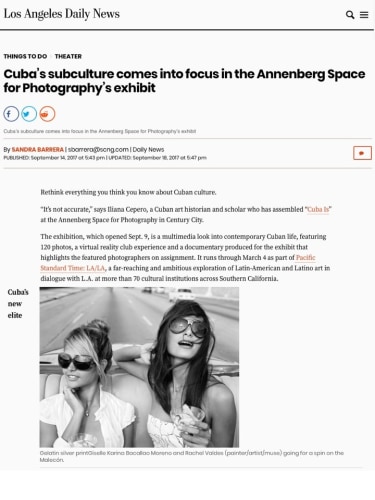Cuba's Subculture comes into focus
Los Angeles Times
09/14/2017
Back
By Sandra Barrera
Rethink everything you think you know about Cuban culture.
“It’s not accurate,” says Iliana Cepero, a Cuban art historian and scholar who has assembled “Cuba Is” at the Annenberg Space for Photography in Century City.
The exhibition, which opened Sept. 9, is a multimedia look into contemporary Cuban life, featuring 120 photos, a virtual reality club experience and a documentary produced for the exhibit that highlights the featured photographers on assignment. It runs through March 4 as part of Pacific Standard Time: LA/LA, a far-reaching and ambitious exploration of Latin-American and Latino art in dialogue with L.A. at more than 70 cultural institutions across Southern California.
In the Annenberg’s exhibition, photographers — Cuban, Cuban-American, American, one Italian, and one Spanish-Chilean — challenge long held perceptions.
Cuba is not a country frozen in time like “Buena Vista Social Club” or the animated music film “Chico and Rita” have reinforced.
“That romantic aura comes from not being able to access the country for so many years,” Cepero says, adding that before 1959, Cuba was a popular destination for Americans in search of a nightlife comparable to New York and Paris. “People have created this mental image of what Cuba is and what Cuba was, and it’s kind of superficial.”
The reality, she adds, is “it’s very rich, it’s very complex, and this show is trying to convince us of that complexity.”
Here are five revealing photographs from the “Cuba Is” exhibit:
Youth culture: A photo from Michael Christopher Brown’s 2015 series Paradiso shows two young women with bright colored hair. The girls are part of a youth subculture in Cuba that emerged in the 1980s and is associated with punk-rock music. Today, they are part of the rave culture.
They party all night and sleep during the day. In the image, the friends sit with their legs crossed, chins resting on their fists and lean into one another while waiting “for their $1 cheese pizzas” in the Playa neighborhood of Havana.
But what makes the image surprising is this could be a scene from any urban center.
“They look like sisters living in Brooklyn the way they dress,” Cepero says. “When I see this photo, I think I’m taking the L train to Williamsburg” often described as the new Soho.
Cuba’s new elite: Michael Dweck’s 2009 series Habana Libre features a photograph of posh young women cruising down the Malecon in the back of a convertible. The women are part of Cuba’s new elite.
For many years, wealth belonged only to high-ranking members of the military and government officials. Today their children and grandchildren, as well as wealthy foreigners who live and invest in Cuba, make up the top 1 percent.
Luxurious estates: A photo by Hermes Mallea and Adrian Fernandez shows the garden facade of a Venetian Gothic-style house, constructed in 1930 for a sugar baron in the style of the palace Ca d’Oro in Venice, Italy.
Many of these grand estates in exclusive communities were built for those in Cuba’s high society before Castro came onto the scene.
“This is a pocket of reality that even Cubans living in Cuba don’t know about,” Cepero says.
Scarcity: Several women gather in a makeshift beauty salon in the Vedado neighborhood of Havana in 1993. The image by Tria Giovan captures a period when Cuba suffered widespread food shortages and malnutrition caused by the fall of the Soviet Union
“Tria captured scarcity,” Cepero says. “And on the other hand, she captured the joy that Cubans tried to preserve in those horrible times.”
Amazing stories: Raul Cañibano’s portrait of a hunter proudly showing off a dead crocodile is part of a story of survival.
The unnamed man suffered a bite to the leg from a crocodile while he slept in a tree on a makeshift bed of branches one night during a hunt with his brother. His brother went for help, leaving the injured man alone and vulnerable in the pitch dark.
Without light, the man fumbled for his first aid kit and stitched up his wound. That morning his brother returned with some men, and they carried him to the doctor.
“When the doctor saw the stitching, he said it was perfect,” Cepero says, explaining that the man told the photographer he learned how to stitch up wounds from a veterinarian friend. The attack didn’t deter the man from hunting.
Cuba Is
When: Opens at 11 a.m. Sept. 9 and runs through March 4; 11 a.m. to 6 p.m. Wednesdays through Sundays
Where: Annenberg Space for Photography, 2000 Avenue of the Stars, Los Angeles
Admission: Free
Information: www.annenbergphotospace.org